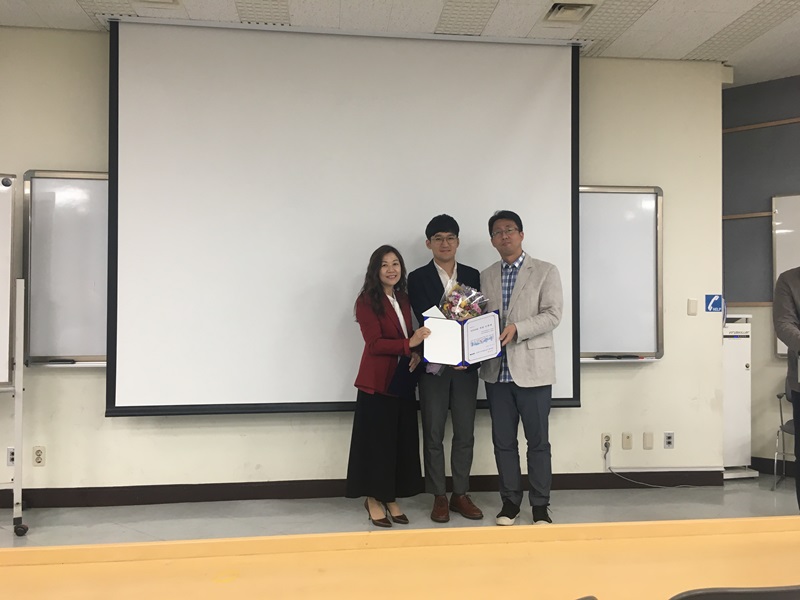NIMS News
Dr. Jang Jae-sung and Doctor Ahn Chi-young won the Journal of the Korean Association for Industrial Applications
2018-10-16Dr. Jang Jae-sung and Doctor Ahn Chi-young won the
Journal of the Korean Association for Industrial Applications
Dr. Jang Jae-sung of the Korea
Institute for Industrial Applications (KSIAM) won the Journal of Industrial
Strategy Research's Award at the Association of Creative Learning in KAIST on
May 25 (Friday) through Saturday.
From left, Chung Eun-ok, president of the Korea Institute for Industrial
Applications, Dr.
KSIAM has selected outstanding papers published in the KSIAM Journal since
2017, and has received the Best Journal Award in 2016 by Dr. Jang Jae-sung and
Ahn Chi-young.
※ Summary: Ultrasonic images are widely used to
visualize the inside of the body during medical diagnosis. The diagnostic
ultrasound industry is steadily growing because it has many advantages such as
no invasions, ease of ment, relatively inexpensive costs and real-time
images. Mathematics is used in various techniques used in ultrasound images,
which describe the history of ultrasound, the basic principles of ultrasound
images, the application of mathematics, the technological trends of domestic
industries and their contribution to mathematics, and the unresolved problems
in ultrasound images.
Abstract : Ultrasound imaging is a widely used tool for visualizing human body’s internal organs and quantifying clinical parameters. Due to its advantages such as safety, noninvasiveness, portability, low cost and real-time 2D/3D imaging, diagnostic ultrasound industry has steadily grown. Since the technology advancements such as digital beam-forming, Doppler ultrasound, real-time 3D imaging and automated diagnosis techniques, there are still a lot of demands for image quality improvement, faster and accurate imaging, 3D color Doppler imaging and advanced functional imaging modes. In order to satisfy those demands, mathematics should be used properly and effectively in ultrasound imaging. Mathematics has been used commonly as mathematical modelling, numerical solutions and visualization, combined with science and engineering. In this article, we describe a brief history of ultrasound imaging, its basic principle, its applications in obstetrics/gynecology, cardiology and radiology, domestic-industrial products, contributions of mathematics and challenging issues in ultrasound imaging.

Dr. Jang Jae-sung and Doctor Ahn Chi-young won the
Journal of the Korean Association for Industrial Applications
Dr. Jang Jae-sung of the Korea
Institute for Industrial Applications (KSIAM) won the Journal of Industrial
Strategy Research's Award at the Association of Creative Learning in KAIST on
May 25 (Friday) through Saturday.
From left, Chung Eun-ok, president of the Korea Institute for Industrial
Applications, Dr.
KSIAM has selected outstanding papers published in the KSIAM Journal since
2017, and has received the Best Journal Award in 2016 by Dr. Jang Jae-sung and
Ahn Chi-young.
※ Summary: Ultrasonic images are widely used to
visualize the inside of the body during medical diagnosis. The diagnostic
ultrasound industry is steadily growing because it has many advantages such as
no invasions, ease of ment, relatively inexpensive costs and real-time
images. Mathematics is used in various techniques used in ultrasound images,
which describe the history of ultrasound, the basic principles of ultrasound
images, the application of mathematics, the technological trends of domestic
industries and their contribution to mathematics, and the unresolved problems
in ultrasound images.
Abstract : Ultrasound imaging is a widely used tool for visualizing human body’s internal organs and quantifying clinical parameters. Due to its advantages such as safety, noninvasiveness, portability, low cost and real-time 2D/3D imaging, diagnostic ultrasound industry has steadily grown. Since the technology advancements such as digital beam-forming, Doppler ultrasound, real-time 3D imaging and automated diagnosis techniques, there are still a lot of demands for image quality improvement, faster and accurate imaging, 3D color Doppler imaging and advanced functional imaging modes. In order to satisfy those demands, mathematics should be used properly and effectively in ultrasound imaging. Mathematics has been used commonly as mathematical modelling, numerical solutions and visualization, combined with science and engineering. In this article, we describe a brief history of ultrasound imaging, its basic principle, its applications in obstetrics/gynecology, cardiology and radiology, domestic-industrial products, contributions of mathematics and challenging issues in ultrasound imaging.



